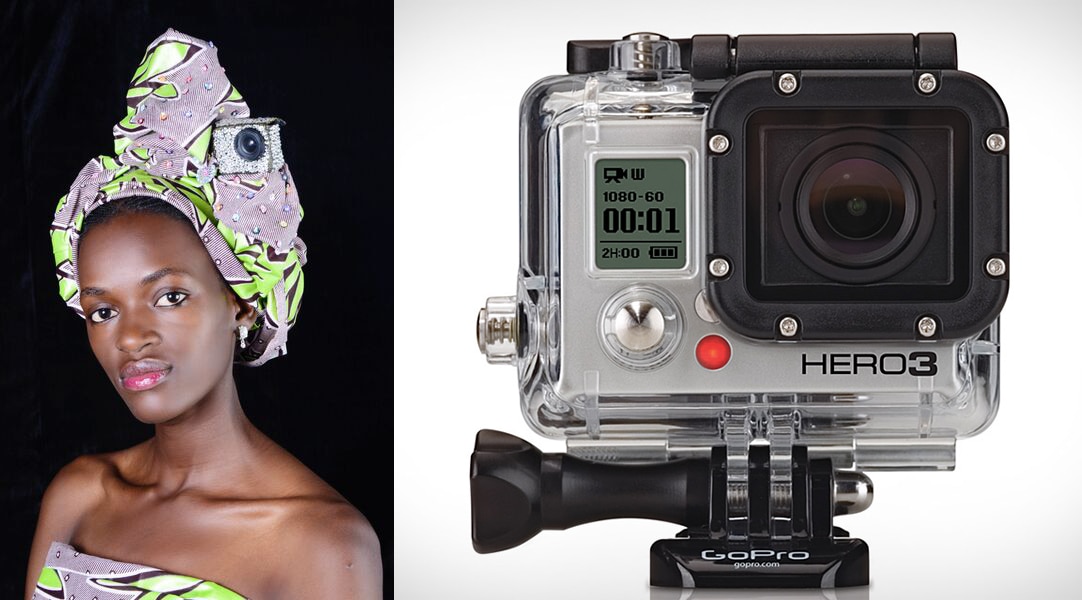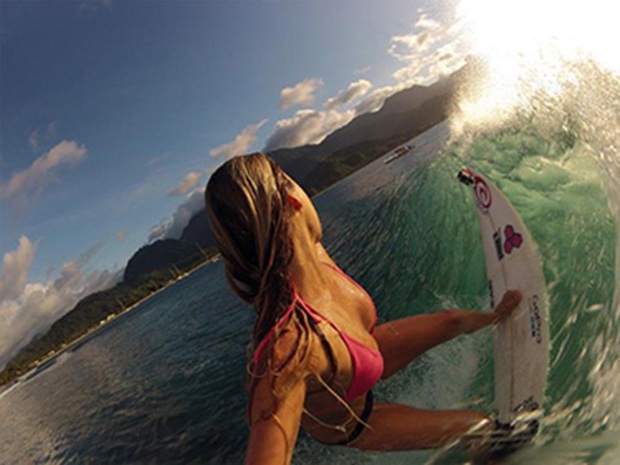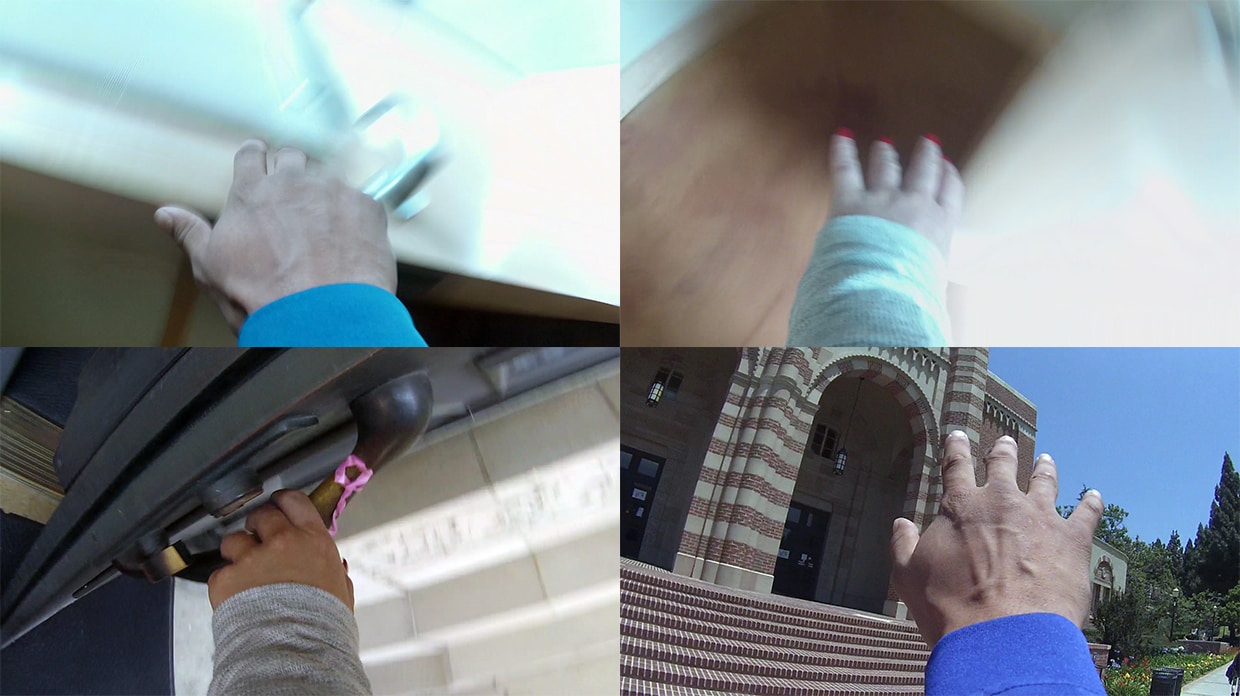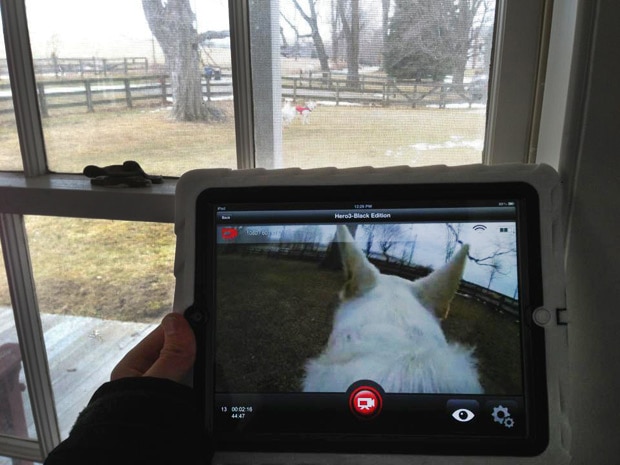From Action Pants to Action Camera: My Hero3

The hyperbolizing of risk, the staging of camera use as a spectacle, and the performance of daring activity to garner attention prevailed in the late 2010s rhetoric surrounding extreme-action sports and adventure and the forms of photography that convey its drama. Though not the first of the “pocket cameras” on the commercial market, the GoPro Hero line is among the most ubiquitously successful video/still cameras on the consumer market currently. The “Brownie” of the contemporary action camera, the tiny GoPro Hero camera was developed by Nick Woodman, a 37-year-old California surfer and former University of California–San Diego computer science and engineering student who graduated with a degree in visual arts. Woodman’s success came in 2012, when the GoPro company sold 2.3 million cameras in the Hero line. The tiny camera was marketed with a waterproof box and a set of straps designed to attach one or multiple cameras to the active body (at the forehead, the chest, the leg), allowing users to self-document action in process from viewpoints linked to the body at points other than the eye. Foxconn’s purchase of 8.8 percent of the company for US $200 million at the end of 2012 brought the camera line’s market value to US $2.25 billion and secured the means for its rapid innovation and market-share growth. 1
To understand the GoPro we must consider Woodman’s role as a camera operator who retooled his camera-body continually, adapting it to the distributed practice of sports action self-documentation. Legend has it that the GoPro is a product of DIY culture, as Woodman raised money to develop it by making necklaces by hand and selling them out of his VW van on California byways frequented by surfers. A surfer himself, Woodman embarked on a tour of beaches in Indonesia and Australia. In one of these locations, he attached a 35mm camera first to the palm of his hand with rubber bands and then to his wrist in an attempt to take action photos from inside the surf. A perhaps artifactual but nonetheless momentous shift occurred with this experiment. The lens of the camera was displaced from the approximate position of the photographer’s eye—where it would, according to convention, be held by the hands of the photographer—down to the level of the hand, to which the camera was literally bound. Tasked with the work of balance and staying aloft, the hand (and with it the camera) followed a dramatically gyrating path. Camera movement was trained exactly to the movement of the surfer as he used his appendages to keep himself upright and balanced, and not to the eye of the cinematographer. The viewfinder, if he had not removed it already, was useless. Much like a pencil or a brush, the camera became, by default, an instrument for rendering a scene “by hand,” and for rendering that scene quite literally in strokes, a word we use to describe both the painter’s action with a brush (as well as the mark this action leaves behind) and the activity of swimming, also powered by the arms and hands. Whereas viewfinder cameras exercise the eye, Woodman’s camera exercised the hand as the driver of the composition. The camera traces a pattern that is not quite arbitrary yet is firmly unmotivated by seeing or even by a semblance or representation of the look. What is documented instead are the phenomenological conditions of immersion—immersion inside the world of water, inside the space of the wave. What is invoked, too, is drawing by hand.
Getting close to the action with a waterproof lightweight sound camera was one of the motivations for the strapped-on camera experiments, which were about documenting not only the body’s movement but also a wide-angle view that maximized the mobile body’s immersion in and passage through the media of water and waves.

Another motivation was to make the equipment inexpensive and easy to use for surfers who wanted action documentation—footage with which to build the requisite portfolio of self-marketing video and photography that could help them “go pro.” That to “go pro” might feature footage not “of” one’s self but shot from one’s own POV (moreover, footage from the “point of view” of one’s hand, chest, or ankle) was a profound shift in the genre of sports action documentation. It also profoundly changed the implications for understanding the subjectivity of the cameraperson in documenting action. The original wrist-mounted point and shoot was redesigned with an ultra-high resolution and professional cinema-quality image. It is WiFi compatible with remote-control and low-light options recording to a micro SD card. The GoPro brings us back to the era of the camera as a tool analogous to the gun, a conjuncture of technologies described and theorized at length by the University of Toronto historian of photography Matt Brower. 2 With the design of the GoPro, the emphasis of self-documentation shifted the tenor of the image’s indexicality away from the document of the photographer’s having been there, to one of the camera-body having done that. Speed and movement register against the stillness of something in the foreground to bring the viewer into close proximity with the immersive conditions and experience of the life-world of the photographer and photographic subject, who are conjoined as one without necessarily ever showing the human face in the frame except incidentally.
This is not to say, however, that GoPro action-camera users are unconcerned about the visual quality of the images they create. It has become standard practice among action-sports camerapersons, rather, to affix the camera to a limb, board, helmet, bike, etc., so that something of the camera-body itself juts into the frame, anchoring a moving image that would otherwise simply twirl and shake. For the viewer of such images, the fragment of the body or vehicle indexes the degree of risk, and creators of such extreme sports videos have developed an array of professional practices to document what they do without using viewfinders.

To create the visual conditions of immersion, even without the use of viewfinders as conventionally understood, is the aim of a variety of DIY tinkerers and corporations seeking to capitalize on the cultural fixation with realism and simulation technologies. The Oculus Rift virtual reality goggles, for instance, work with a multiple-camera-holding contraption that does not make use of viewfinding per se, but is nonetheless calibrated by design to afford the post-production stitching of the footage into an immersive, 360-degree virtual reality experience. 3
In the end, we are not interested in the internalization of the viewfinder into the phenomenological orientation of the action-camera operator as a means to ever more novel configurations of visual spectacle and realism. We trace our theory of viewfinderlessness to performance art in part for the connection we see to ideas about absence and disappearance at the core of the genre, as well as a focus on everyday spaces and routines. In this regard, we revisit Krauss’s notion of the medium of video as narcissism in the context of urban milieus that are far more saturated with video din and in which many more people are dislocated from ancestral homelands than in the 1970s. Here we see uses for the viewfinderless action camera to again disrupt time-spaces on offer and to foreground the place of performance in escaping from the trappings of self, an effort that may be assisted by affixing wearable cameras to the body. Much like the Portapak, the GoPro technology centers a variety of social communities who use the cameras in an assortment of ways. While the action-sports branding of the camera tends to produce affinity groups among young white YouTubers venturing out on adventures with friends to distant locales, the cameras themselves may be taken up to represent the phenomenological experiences of persons with disabilities, or everyday walks reminiscent of Acconci’s Following Piece and EXPORT’s Adjunct Dislocations, as in Xiaowen Zhu’s Wearable Urban Routine (2011).
In this performance, Xiaowen reenacts in the city of Rotterdam the ascetic ritual of meditative walking practiced by the Tendai Buddhist monks of Mt. Hiei in Japan. In the summer of 2011, she traced the same path through the city daily over the course of two weeks. The Tendai monks of Mt. Hiei, dressed in white robes, straw sandals, and a rectangular three-foot-long straw hat called a renge gasa, embark on an arduous quest for enlightenment known as the Kaihogyo, in which every day for 100 straight days they visit approximately 250 pilgrimage sites spread across 30 kilometers, followed by nine consecutive days of meditating without food, water, or rest, a practice repeated over the course of seven years. Xiaowen, a native of Shanghai, dressed in a white robe and made her own renge gasa, reminiscent of those worn by Tendai monks, for her performance, affixing a forward-facing action camera to the back of the hat to record a single over-the-shoulder take of her daily walk. She attached a miniature projector to the front of the hat to project the recording of the previous day’s walk onto the surface just in front of her feet. Xiaowen explained that in this way, she “could observe the old walking while performing the new one.” Like EXPORT’s Adjunct Dislocations, Xiaowen’s performance invited the gaze of curious onlookers in the city and reflected upon the cinematic apparatus by creating one that functioned as an extension of her body. But Xiaowen’s action-camera-body aimed for the safety of concentrated focus rather than the transgressive risk entailed in the work of Acconci and EXPORT. She was not reenacting the masculine ritual of the Tendai monks, whose trial is designed to bring participants into intimate contact with death. Her performance aimed rather to enable her concentration on the everydayness of walking, and the flat, nondescript ground just in front of her steps. Xiaowen explained that the projected video guided her attempt to replicate the walk, focusing her concentration—monk-like—on “the simple act” amid the distracting din of the city. Viewfinderless-camera use in live video performance, in other words, here aimed to enable a space for reflection amid a city saturated with signs that compete for the flaneur’s attention. Moreover, digital production now allows for a greater breadth of hypermedia creations than was possible when EXPORT made Adjunct Dislocations. Xiaowen could immediately upload the digital record at the end of her walk, and could combine multiple takes of the walk in a composite image using nonlinear editing software—a further extension of the camera-body in time and space. Ultimately, the digital footage of Wearable Urban Routine was displayed as a twelve-channel, four by three gallery installation. Because Xiaowen walked the same route daily and had the video record from the day before projected to guide her walk, in the finished hypermedia video she was able to more or less sync up the twelve different walks she took across two weeks. In each video recording, she passes the same locations at roughly the same time, allowing the viewer to reflect upon sameness and difference in the images. On at least one of the walks, a cameraperson documented Xiaowen at a distance, much like the documentary cameraperson for EXPORT’s Adjunct Dislocations, to create a brief online video explaining the project. Wearable Urban Routine exists as a live performance of reenactment and documentation, a gallery installation, and an online video and description. Xiaowen’s reflections on the process of creating the work reveal an intra-subjective dynamic, an intertwining of self and viewfinderless camera-body into an organism that develops a resistance to boredom and a heightened sensitivity to the small details of the landscape over time: “Each small detail became outstanding against the backdrop of sameness,” she recalled. “I was not for a second feeling bored.” 4
Heroic Viewfinderlessness
The demise of viewfinding as a central activity deserves considerable attention with respect to the major shift in concepts of subjectivity effected by the removal of this feature from the GoPro Hero and similar camera models in the “pocket camera” genre. A viewfinder allows the photographer to identify and establish what he or she sees and to select and frame the view. “Viewfinderlessness,” a term used throughout this essay, was in fact coined to decry this trend. In the case of the GoPro, viewfinding is a potential activity (there are apps for viewfinding from one’s phone or iPad, for example); however, the phenomenological and ontological experience of the photographer as one who locates him or herself in relationship to the frame is undercut as viewfinding because this activity has been unmoored from the body of the camera and made an optional side feature associated with computing and communication. The take is achieved without the photographer ever really seeing what it is that is filmed. Although marketed in 2013 with the phrase “see what your camera sees with live preview,” the preview function advertised is through a remote app. The physical position of the camera and its lens and the physical position of the camera operator in the act of selecting a shot are thus split, with operation of the camera as well as viewfinding potentially occurring from a second, remote location. What concerns us here is the splitting of the subjective position of the camera “eye” (which may be multiple, emanating from the foot, the arm, or the chest) and the relegation of the photographer’s preview to an explicitly diminished simulacrum of the real to come.

Heroic POV
The figure of the hero—which the product name of GoPro’s Hero line of cameras invokes—is tacitly understood to be “myself.” By strapping cameras to my body in multiple places, “I” multiply, redistribute, and reassign my look, and the power to which it is attached, to nodes across my entire body, nodes from which the camera-body multiple emanates. I even extend my gaze to additional apparatuses, the surfboard or the skateboard to which I affix the camera, or the balloon in which I send the camera up unmanned, tethered to my hand by a string, remotely controlling its path from below using the device’s inbuilt remote tracking feature.
We have noted that the GoPro, in one of its primary uses, offers a displaced and potentially multiple POV shot (with the use of multiple cameras). In cinematic filmmaking, the POV shot is evident as such not in the shot in itself but by viewing a sequence and juxtaposition of shots. In the first shot we may see a character who appears to be looking at something; in the second we see what the character has apparently seen; and in some cases a third shot returns to the face of the character to show his or her reaction to the sight to which we have become privy.
In the case of GoPro footage, the preceding shot of the face that looks is eliminated. What was a unitary subject’s gaze, represented by one mobile tracking shot taken from the implied position of the eyes, is fragmented with the use of multiple cameras. The act of looking in which one identifies with the position of the camera is displaced and multiplied across non-ocular locations on the body of the viewing subject. Seeing multiple angles like this from multiple points of view is famously disorienting and exhilarating, an effect that is a hallmark of GoPro’s branding as a tool for “going pro,” for revealing heroism in the form of video and photography that puts the spectator in a body that is all eyes, multiplying the gaze and making it ubiquitous, even as its centrality in the consciousness of the photographer is unfixed.
In this essay we have attempted to provide an early sketch of a historical framework through which to perform a media archaeology of the phenomenon of the viewfinderless action camera, proposing that precedents may be found not only in the history of photography but also in the history of medical engineering and in media and performance art practice. One might expect an archaeology of a technology of the body to take us inside, opening up the black box. Instead, we find the camera’s interior mechanisms opened out to the surface and its functions attaching coextensively to the world around it without the oversight of the operator’s organizing gaze. The viewfinderless body-mounted camera is an apparatus that asks us to unman our own eyes and at the same time become a body studded with its many eyes, as it holds out the offer: “be a Hero.” The offer to be a hero is, of course, an ontologically organized lure, the promise of becoming a camera-body through a fragmented coextensive relationship of immersion in the life-world of distributed intersubjectivity with technology. We have remained ambivalent, if not neutral, on the question of the politics of this form of subjectivity. Like all relationships with technology, experiences of viewfinderlessness and the camera-body relationship are open to a range of potential becomings.
- Woodman’s success has been featured in venues including The New York Times (Nick Wingfield, “GoPro Sees Opportunity in Its Amateur Daredevils,” The New York Times, January 30, 2014); Fortune (Michael Lev-Ram, “How Nick Woodman Modeled GoPro after Red Bull,” Fortune, October 20, 2014); and Forbes (“#389 Nicholas Woodman,” listed in “Forbes 400”), which chronicles the entrepreneur’s net worth.[↑]
- Matthew Brower, Developing Animals: Wildlife and Early Photography (Minneapolis: University of Minnesota Press, 2010).[↑]
- See, for example, this advertisement for the “World’s First Fully Spherical 3D 360 Video and Photo Gear,” at the 360Heros website.[↑]
- Xiaowen Zhu, Wearable Urban Routine (2011), Institute for the Unstable Media. [↑]


